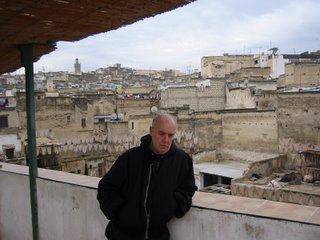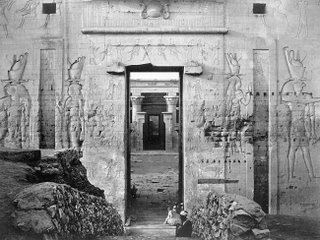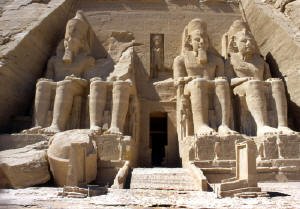
Short answer: very, very safe. If you're looking for trouble-- in Mexico City or anywhere else-- you can surely find it. But all the hype about Mexico City being a dangerous place for American tourists seemed to me to be completely unfounded. I had a quasi-revelation while I was there about why. There's a subway stop at the airport. It costs 25 American cents to go anywhere in the city. I took it to my hotel and it was simple and clean and took 25 minutes. A taxi takes between an hour and an hour and forty-five minutes... depending on congestion caused by road building. And taxis cost... well, that's where the hype comes in. It's an oft repeated truism in Mexico City that if you take a "street cab" you
could be kidnapped and held for ransom. It has happened-- only not to tourists. It has happened to
rich and upper middle class Mexicans. There appears to be a ring of kidnappers in cahoots with some elements of the police who kidnap rich Mexicans and ransom them. The game doesn't work on tourists.
I took street taxis around Mexico City frequently. No problems whatsoever, although the fine folks at the hotel, especially the door staff, were adamant it was dangerous. A metered "street taxi" from my hotel to the great restaurants in the Polanco district costs around $3. The hotel cars that are always being pushed charge $20 for the same ride and the SITIO cabs the hotels claim are safe also try getting away-- no meters-- with $20. Those numbers explain the hyped up danger stories. The motive is very significant profit. The American ex-pats I spoke to in Mexico City laughed about it. They all take street cabs.
No matter where I travel, the employees at the upper end hotels always tell me "it's too far to walk." It never is. In Mexico City they
also claimed it was too dangerous for me and my two robust friends to walk from Paseo de la Reforma to a market about a mile away. The walk brought us away from the architecturally stunning Reforma and into the "real" day-to-day Mexico City. Dangerous? Not even a little.
Last week I mentioned I was going to go to
El Museo Dolores Olmedo in Xochimilco. It took almost an hour by subway and then a little train ride (25 cents on each). It costs $4.50 to get in, although they accepted my L.A. County Museum of Art membership card as a substitute and they accepted a teacher's ID from a friend. (All 3 museums I went to happily accepted the L.A. museum card for free entry.) Anyway,
Dolores Olmedo, who died 6 years ago, was Diego Rivera's patron (and longtime lover-- and, rumor has it, also Frida Kahlo's lover, if more briefly). Her gorgeous, magical estate in the middle of the city-- although it certainly seems like you're far from any city-- has been turned into an art museum specializing in the works of Rivera and, to a lesser, but still significant, extent, Kahlo. I had been to Mexico City many times before but had never gone there before. I'm sure I'll be back... every time I visit Mexico City.
The
Tamayo Museum in Chapultepec Park was a huge disappointment. I remember it as a spectacular building housing an even more spectacular collection of Tamayo art. The building is still super. The art... no. There were no Tamayos. Instead there were 4 absolutely wretched exhibitions that had to be justified with long explanations because they were so obviously mediocre. The first one we wandered into was 3 rooms of photos of toilet paper and urine by a radical Brazilian named
Artur Barrio. A few years ago I decided to stop being a member of the Museum of Contemporary Art in L.A. because the work grasped at trying to be art and instead was just a bunch of ugly intellectual polemics. Barrio's work was far worse than anything I ever saw at MOCA.
Canadian photographer
Jeff Wall had an exhibition that wasn't offensive at all-- nor was it remotely interesting. It just filled some space with big, well-lit photos. Swedish photographer
Henrik Hakansson also had a huge exhibition. It could have been called "Snapshots from my dull trip to Chiapas."
Pablo Pijnappel I would have voted to pass on but my two companions are Dutch and they were fascinated by his Dutch last name. We gave his unremarkable video a minute before leaving, a minute more than it was worth. Almost any random YouTube clip would have been more interesting and artistic.

El Museo de Arte Moderno has a kick-ass sculpture garden
Fortunately I then remembered that across the street, still in Chapultepec, was one of the western hemisphere's greatest modern art museums, the
Museo de Arte Moderno. There were plenty of Tamayos, of course, as well as a spectacular sampling of Mexico's greatest contemporary artists: Rivera and Kahlo of course, and Siqueiros, Gerzco, Orozco, Galan, Costa, Carrington, etc. Between the permanent collection and the unbelievable sculpture garden, it is easy to while away a day at this beautiful oasis. We also saw a career retrospective of
Remedios Varo Uranga. At first I thought the work was by some hippie in the 60s who was smoking a lot of Acapulco gold. Then I realized she was born in 1908 and had a vision way ahead of the trends. Definitely worth checking out.
The other day I mentioned I had gone to the
culinary apex of Mexico City, Izote. The following night my friends wanted to eat on the roof of their hotel, the
Best Western Majestic, which has a great view of the Zocolo and the National Palace but extremely mediocre food. We made up for it the following night when I got the fantastic concierge at the Embassy Suites to recommend something as good as Izote. He did: Pompano. It's not far from Izote in Polanco and, like it, it offers a modern-- and healthful-- delicious take on Mexican cooking. It's a seafood restaurant and the sampler of 3 cerviches was, simply put, the best cerviche I had ever tasted. Everything each of us ate was spectacular and I can't recommend this place too highly. It's at #42 Moliere in the old Jewish section of town (and not far from a fully functioning synagogue at Eugenio Sue).
UPDATE: BUT THINGS ARE DETERIORATING The good news is that prices are going down on hotels and tourist-related things. The bad news is that Mexico is rated
about as likely as Pakistan to disintegrate! The U.S. Joint Forces Command warns that Mexico's "government, its politicians, police and judicial infrastructure are all under sustained assault and press by criminal gangs and drug cartels. How that internal conflict turns out over the next several years will have a major impact on the stability of the Mexican state. Any descent by Mexico into chaos would demand an American response based on the serious implications for homeland security alone."



































